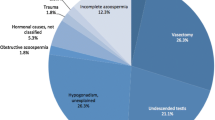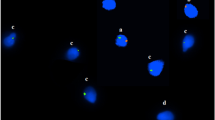Abstract
Objective: Our objective was to investigate the fertilizing ability of human sperm from severe male-factor patients, by microinjection of single sperm into the hamster oocyte.
Design: Semen samples of severe male factor either with a 0% penetration rate in the zona-free hamster test or with a very low number of motile sperm for which performing the standard penetration test was impossible were used. For the control study, oligozoospermic semen samples with at least 10% penetration rate in zona free hamster test were used.
Setting: All materials were collected from the National University Hospital, Singapore.
Methods: There were 10 patients in both the experimental and the control groups. Intracytoplasmic sperm injection (ICSI) was carried out. The main outcome measures were sperm head decondensation and pronuclear formation.
Results: Twenty-one percent of the injected sperm could decondense and undergo male pronuclear formation. This rate was not significantly different from that in the control study group (28%; P=0.13). A small proportion of the oocytes was damaged during the procedure (9.2 and 8.75% in experimental and control groups, respectively).
Conclusions: Hamster-ICSI assay may be of benefit in predicting the sperm's ability for further development before allowing the patient to undergo the clinical program.
Similar content being viewed by others
References
Uehara T, Yanagimachi R: Microsurgical injection of spermatozoa into hamster eggs with subsequent transformation of sperm nuclei into male pronuclei. Biol Reprod 1976;15:467–470
Van Steirteghem AC: IVF and micromanipulation techniques for male factor infertility. Curr Opin Obstet Gynecol 1994;6:173–177
Liu J, Nagy Z, Joris H, Tournaye H, Devroey P, Van Steirteghem AC: Intracytoplasmic sperm injection does not require special treatment of the spermatozoa. Hum Reprod 1994;9:1127–1130
Ahmadi A, Ng SC, Liow SL, Ali J, Bongso A, Ratnam SS: Intracytoplasmic sperm injection of mouse oocytes with 5* mM Ca2+ at different intervals. Hum Reprod 1995;10:431–435
Skoblina MN: Behaviour of sperm nuclei injected into intact ripening and ripe toad oocytes and into oocytes ripening after removal of the germinal vesicle. Sov J Dev Biol 1974;5:294–299
Yanagimachi R: Zona-free hamster eggs; Their use in assessting fertilizing capacity and examining chromosomes of human spermatozoa. Gamete Res 1984;10:187–232
Palermo G, Joris H, Devroy P, Van Steirteghem AC: Pregnancies after intracytoplasmic injection of a single spermatozoon into an oocyte. Lancet 1992;340:17–18
Van Steirteghem AC, Nagy Z, Joris H, Liu J, Staessen C, Smitz J, Wistano A, Devroey P: High fertilization and implantation rates after intracytoplasmic sperm injection. Hum Reprod 1993;8:1061–1066
Chang MC: Fertilizing capacity of spermatoza deposited into fallopian tubes. Nature 1951;168:697–698
Iwamatsu T, Chang MC: Sperm penetration in vitro of mouse oocytes at various times during maturation. J Reprod Fertil 1972;31:237–247
Kistler WS, Geroch ME, Williams-Ashman HG: Specific basic proteins from mammalian testes. Isolation and properties of small basic proteins from rat testes and epididymal spermatozoa. J Biol Chem 1973;248:4532–4543
Pagany EC, Corzett M, Weston S, Balhorn R: DNA and protein content of mouse sperm. Implications regarding sperm chromatine structure. Exp Cell Res 1982;136:127–136
Calvin HI, Bedford JM: Formation of disulfide bonds in the nucleus and accessory structures of mammalian spermatozoa during maturation in the epididymis. J Reprod Fert 1971;13(Suppl):65–75
Balhorn R: A model for the structure of chromatin in mammalian sperm. J Cell Biol 1982;93:298–305
Ward WS, Coffey DS: DNA packaging and organization in mammalian spermatozoa: Comparison with somatic cells. Biol Reprod 1991;44:569–574
Perreault SD, Wolff RA, Zirkin BR: The role of disulfide bond reduction during mammalian sperm nuclear decondensation in vivo. Dev Biol 1984;101:160–167
Poccia D: Remodeling of nucleoproteins during gametogenesis, fertilization and early development. Int Rev Cytol 1986;105:1–65
Perreault SD, Naish SJ, Zirkin BR: The timing of hamster sperm nuclear decondensation and male pronucleus formation is related to spem nuclear disulfide bond content. Biol Reprod 1987;36:239–244
Mahi CA, Yanagimachi R: Induction of nuclear decondensation of mammalian spermatozoa in vitro. J Reprod Fertil 1975;44:293–296
Das CC, Kaufmann BP, Gay H: Histon protein transition in drosophila melanogaster. II. Changes during early embryonic development. J Cell Biol 1964;23:423–430
Kopency V, Pavlok A: Autoradiographic study of mouse spermatozoa arginine-rich nuclear protein in fertilization. J Exp Zool 1975;191:85–96
Lanzendorf S, Maloney M, Ackerman S, Acosta A, Hodgen GD: Fertilizing potential of acrosome-defective sperm following microsurgical injection into the eggs. Gamete Res 1988;19:329–337
Lassalle B, Testart J: Human sperm injection into the perivitelline space (SI-PVS) of hamster oocyte: Effect of sperm pretreatment by calcium-ionophore A23187 and freeze-thawing on the penetration rate and polyspermy. Gamete Res 1988;20:301–311
Ng SC, Bongso TA, Sathananthan AH, Tok VCN, Ratnam SS: Micro-centrifugation of human spermatozoa: Its effect on fertilization of hamster oocytes after micro-insemination spermatozoal transfer. Hum Reprod 1990;5:209–211
Dozortsev D, De Sutter P, Dhont M: Behaviour of spermatozoa in human oocytes displaying no or one pronucleus after intracytoplasmic sperm injection. Hum Reprod 1994;9:2134–2144
Author information
Authors and Affiliations
Rights and permissions
About this article
Cite this article
Ahmadi, A., Bongso, A. & Ng, S.C. Intracytoplasmic injection of human sperm into the hamster oocyte (hamster ICSI assay) as a test for fertilizing capacity of the severe male-factor sperm. J Assist Reprod Genet 13, 647–651 (1996). https://doi.org/10.1007/BF02069643
Received:
Accepted:
Issue Date:
DOI: https://doi.org/10.1007/BF02069643




